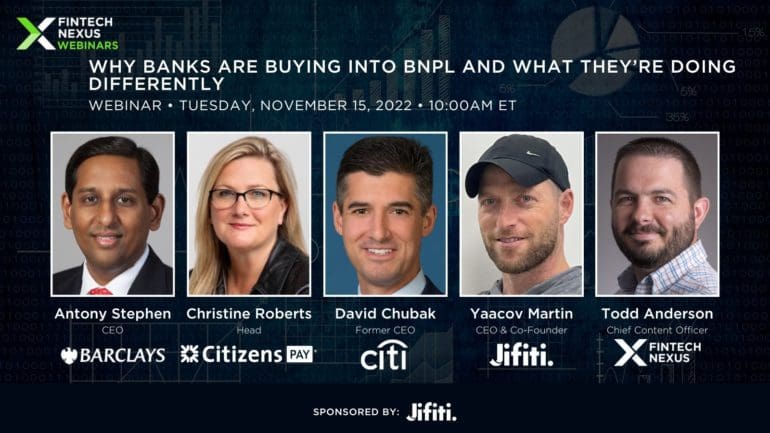A year ago, the BNPL industry faced its highest corporate valuations yet. A splurge of BNPL blew up the news cycle as the payments industry faced a possible credit card challenger.
Today, the world looks different, but as industry experts reported, banks are still onboarding BNPL tech, despite an 85% cut in valuations. What are they going after, and why? Register here to check out the full webinar.
Moderator Todd Anderson began by thanking Jifiti for setting up the webinar and then introducing the hosts. Yaacov Martin, CEO of Jifiti, started by clearly defining the type of BNPL they offer their clients.
“I think all of us here on the panel, at least have been involved in this industry way before Buy Now Pay Later was in, it was often referred to as consumer finance or point of sale finance,” Martin said.
BNPL and Split pay
As CEO and co-founder, he said Jifiti works with banks and merchants to provide consumers and businesses with various finance and financial products at the point of sale. He said they called most BNPL split pay and that there are many different products. The most significant differentiator is regulations, he said.
“There are many different products with a fundamental differentiation, I would say that is those that are regulated and those which are not,” Martin said. “Internally, we adopted the term split pay, which we’ve all seen proliferate in many areas of the world in the last two or three years: they are generally yet to be fully regulated.”
The regulated type generally follows fundamental underwriting, Martin said.
David Chubak, head of Wealth Management at Edward Jones, said he used to head Citi Bank Retail services, connecting Merchants like Macy’s and Home Depot with providers like JIfiti.
He said some fintech practitioners create complexity out of simplicity in an ironic way.
“I joke with a couple of my former clients and partners who are big retailers that they’ve been in the Buy Now pay later business for many decades. We used to call it layaway, a term no one likes to use anymore,” Chubak said. “It’s gone on the wayside in place of innovation of POS financing and Buy Now Pay Later.”
He said it’s all about the client experience, enabling clients to afford the purchases they want using seamless lending. Banks today want “Anything, whether a product or a service, that ties into the broad ecosystem to help bring clients and merchants together to create an ecosystem.”
What are the impacts of a new system?
Anderson asked the banks in the room what effects they saw coming now that more banks are adopting new ecosystems of payments. Christine Roberts, President of Citizens Pay, said they focus on pay over time through partners like Apple Pay. She said that the payments philosophy of BNPL fits well with gen Z as a clear-cut option that is not credit cards.
“They will use credit cards, but they experienced the financial crisis of 2008 as children of parents who suffered financial hardships with debt and borrowing,” Roberts said. “One of their principles is being able to understand their payment structure; they like BNPL or pay over time afford to seller financing, is that it’s a very defined to payment amounts per month.”
Say a zoomer wants to buy a couch; Roberts said they like knowing that $1,000 will be split evenly into payments of $100 a month over some time. Compared to credit cards, which just show minimum amounts and twenty-year periods, she said BNPL terms are more precise.
She said raising rates that affect variable rate cards also makes BNPL more attractive.
“During the rising rate environment, they’re seeing the effects within their credit card bills where you have variable rates,” Roberts said. “The thing about both Buy Now Pay Later and pay over time offerings is that they’re all either 0% or fixed rate, so there’s no fluctuation in their payments over the time they’re going to pay.”
Offer BNPL or someone else will
Antony Stephan, CEO of Barclays Partner Finance, said his wing handles private debt financing and BNPL. He said he’s only a year into his firm, but Barclays has been doing point-of-sale financing for 20-some years. He said there are two sides to the question, from the consumers and the merchants.
“Banks have a large client base and have to offer customers payment products they like. It’s a popular method embraced by a significant portion of the population; banks have to offer it,” Stephen said. On the other side of the question, Barclays, while acquiring partners in small businesses and large corporates as a significant market share here in the UK: those merchants are saying ‘this is the preferred payment by consumers to shop on my site.”
He said banks realize that if they don’t offer BNPL and split pay, someone else will. Stephen called BNPL an evolution of payment offerings, from cash to check and debit cards and credit cards; if “banks want to stay relevant, they have got to offer it,” he said.






